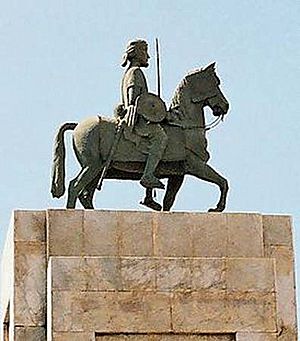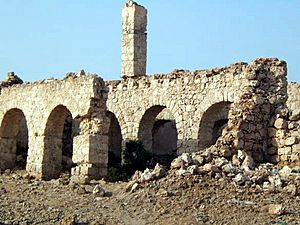Ahmad ibn Ibrahim al-Ghazi facts for kids
Quick facts for kids Ahmad ibn Ibrahim |
|
|---|---|
| Imam and General of the Adal Sultanate | |

|
|
| Reign | c. 1527 – February 21, 1543 |
| Predecessor | Mahfuz |
| Successor | Nur ibn Mujahid |
| Born | c. 1506 Hubat, or Zeila Adal Sultanate |
| Died | February 21, 1543 (aged 36–37) Wayna Daga, Ethiopian Empire |
| Spouse | Bati del Wambara |
| Issue | Mohammad ibn Ahmad |
| Religion | Islam |
Ahmad ibn Ibrahim al-Ghazi (Somali: Axmed Ibraahim al-Qaasi or Ahmed Gurey, Harari: አህመድ ኢብራሂም አል-ጋዚ, Arabic: أحمد بن إبراهيم الغازي ; c. 1506 – 21 February 1543) was a powerful Somali leader. He was an Imam (a Muslim religious leader) and a general of the Adal Sultanate. He is famous for leading his army against the Ethiopian Empire.
Ahmad was often called Gurey in Somali, Gura in Afar, and Gragn in Amharic. All these names mean "the left-handed." With a large army, mostly made up of Somalis, he conquered a big part of Abyssinia (which is now Ethiopia). This happened during a major conflict called the Ethiopian-Adal War.
Who Was Ahmad?
Most experts believe Imam Ahmad was from the Somali group. However, some historians have different ideas about his background. For example, some suggest he might have been connected to the Harla or Wâlasma families. Others think he might have been Harari, Afar, or Balaw.
Many Somali groups joined Ahmad's fight in Abyssinia. They fought not just as Somalis, but as Muslims. One old record says that Ahmad once left the city of Harar to live among Somalis. He often helped solve problems between different Somali groups.
A historian named R. S. Whiteway wrote about Ahmad's early life. He said that Ahmad was the son of Ibrahim el Ghazi. Both Ahmad and his father were regular soldiers. Whiteway thought Ahmad was probably a Somali because he was close to many Somali people.
Another historian, I. M. Lewis, pointed out that there might have been two different leaders named Ahmad Gurey. He suggested that over time, stories about these two leaders might have blended into one heroic figure.
An Ethiopian historian, Takla Sadiq Makuria, also looked into Ahmad's background. He used old records and stories from Harar. Some of these stories suggest that Ahmad's father came from the Hawiya Somali clan.
Ahmad's Early Life
Imam Ahmad was born around 1506. His birthplace was either Hubat or Zeila, both in the Adal Sultanate. He spent much of his childhood in the city of Harar.
At one point, Ahmad left Harar because he disagreed with the ruler, Sultan Abu Bakr ibn Muhammad. He joined a leader named Adashe, who became a sultan. Ahmad and his father became important soldiers in Adashe's army.
Adashe was a Harari leader who fought against the Somali rulers of Zeila. He became the sultan of Adal. But his rule did not last long. Abu Bakr ibn Muhammad, a Somali sultan, rebelled and defeated Adashe. Abu Bakr then took control of Harar.
Many people did not like Abu Bakr. They joined Ahmad's forces because Ahmad wanted to avenge Adashe's death. Ahmad fought Abu Bakr, defeated him, and became the new sultan of Adal.
Ahmad married Bati del Wambara, who was the daughter of Mahfuz. Mahfuz was the Governor of Zeila. In 1531, Ahmad and Bati had their first child, a son named Muhammad.
After Mahfuz died in 1517, the Adal Sultanate faced a period of disorder. Imam Ahmad eventually took control of Harar and brought stability back. Some historians also say that Ahmad helped many Oromo people convert to Islam during his rise to power.
In 1529, Ahmad's army invaded Abyssinia. This was in response to an attack on Adal the year before. Ahmad's forces had many muskets, which were new and powerful guns bought from the Ottomans. These weapons surprised the Abyssinian soldiers. Ahmad defeated Emperor Dawit II at the Battle of Shimbra Kure in March of that year.
War with Abyssinia
Ahmad's invasion of Abyssinia is a very important part of history. It is described in many old records from Somalia, Abyssinia, and other countries.
In 1531, Imam Ahmad continued his campaign in Abyssinia. He greatly weakened Emperor Dawit II's army at the Battle of Amba Sel on October 28. After this victory, Ahmad's Muslim army marched north. They looted the island monastery of Lake Hayq and the famous stone churches of Lalibela.
When Ahmad reached the province of Tigray, he defeated another Abyssinian army. He then went to Axum and destroyed the Church of Our Lady Mary of Zion. This church was very important because Abyssinian emperors had been crowned there for centuries.
The Abyssinians needed help, so they asked Portugal. Portuguese soldiers arrived at the port of Massawa on February 10, 1541. This was during the rule of Emperor Gelawdewos. The Portuguese force had 400 soldiers with muskets, plus other skilled workers.
The Portuguese leader, Cristóvão da Gama, met Imam Ahmad on April 1, 1542, at a place called Jarte. A Portuguese writer described seeing Ahmad: "While his camp was being set up, the king of Zeila [Imam Ahmad] went up a hill with some horsemen and foot soldiers to look at us. He stopped at the top with three hundred horsemen and three large flags. Two flags were white with red moons, and one was red with a white moon. These flags always stayed with him, and people knew him by them."
On April 4, da Gama's troops marched against Ahmad's army. They used their muskets and cannons to push back the Muslim attacks. Ahmad was wounded in the leg during this battle. His flags signaled a retreat, and the Portuguese and their Abyssinian allies attacked the disorganized Muslim forces.
Over the next few days, Ahmad's army received more soldiers. Da Gama attacked Ahmad's camp again on April 16. The Portuguese almost won completely, but Ahmad was carried away from the battle.
Later, da Gama joined forces with the Bahr Negus Yeshaq. They followed Ahmad's army. However, the start of the rainy season stopped da Gama from fighting Ahmad a third time. Da Gama set up camp near Lake Ashenge, while Ahmad camped on Mount Zobil.
Imam Ahmad asked for more help. He received 2,000 musketeers from Arabia and 900 skilled soldiers and artillery from the Ottomans. Meanwhile, da Gama's force had shrunk to only 140 musketeers due to losses. After the rains ended, Imam Ahmad attacked the Portuguese camp. He killed most of da Gama's troops. Da Gama himself was captured and executed after he refused to convert to Islam.
The remaining Portuguese soldiers and Emperor Gelawdewos then joined together. Using the Portuguese muskets, they attacked Ahmad on February 21, 1543, at the Battle of Wayna Daga. Their army of 9,000 defeated Ahmad's 15,000 soldiers. Imam Ahmad was wounded while trying to escape and was killed by a young Abyssinian commander named Azmach Calite.
Ahmad's wife, Bati del Wambara, escaped with some Turkish soldiers back to Harar. She gathered his followers and married his nephew, Nur ibn Mujahid. She made him promise to avenge Ahmad's death. In 1550, Nur started a holy war but was pushed back. Later, in 1559, he invaded another area, and Emperor Gelawdewos was killed in battle.
Legacy
Paul B. Henze wrote that "In Ethiopia the damage which Ahmad Gragn did has never been forgotten." Even today, Christian highlanders in Ethiopia still hear stories about Gragn. Emperor Haile Selassie mentioned him in his writings. He said that villagers would show him places destroyed by Gragn, as if it happened just yesterday.
For most Somalis, Ahmad is seen as a national hero. They remember him as a leader who fought against attacks on their ancient lands.
Images for kids
See also
 In Spanish: Ahmad ibn Ibrihim al-Ghazi para niños
In Spanish: Ahmad ibn Ibrihim al-Ghazi para niños



